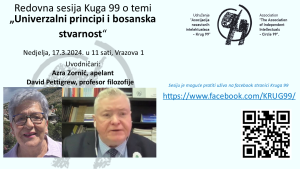THE SERB REPUBLIC AND THE (UN)DISMANTLED HERZEG-BOSNA STILL EXIST

| Krug 99 (Circle 99), 18 June 2023 – 35 Sarajevo, Bosna and Herzegovina CAN THE SERB REPUBLIC AND THE (UN)DISMANTLED HERZEG-BOSNA STILL EXIST IN VIEW OF DECISIONS BY THE HAGUE TRIBUNAL? The International Criminal Tribunal for the Former Yugoslavia considered war crimes during the conflict of 1991 to 1995 on the territory of the Republic of Bosnia and Herzegovina and cited in its court decisions the doctrine of the joint criminal enterprise. That is the legal doctrine employed in the prosecuting of war crimes dating from the Nuerenberg process to today. A joint criminal enterprise has a criminal objective and people mutually connected in order to achieve that objective. Concerning the two joint criminal enterprises against the Republic of Bosnia and Herzegovina, one embodied the idea of a Greater Serbia, while the other advanced the cause of a Greater Croatia. In order to achieve these objectives on the territory of Bosnia and Herzegovina, Serbia formed the para-state creation of the Serb Republic [“Republika Srpska” – RS], while Croatia created the Croatian Republic of Herzeg Bosna (“Hrvatska Republika Herceg Bosna” – HRHB). In carrying out these objectives, the organs of authority and military structures of the joint criminal enterprises committed war crimes, including the crime of genocide for which punishments were meted out by the Hague Tribunal. The structure of the joint criminal enterprises against the Republic of Bosnia and Herzegovina was comprised of: a) the highest political authorities in Serbia and Croatia, i.e. the President of Serbia and the President of Croatia; b) commanders and the highest-ranking members of military, law enforcement and quasi-police units in Serbia and Croatia; c) the highest political authorities of the Croatian para-state creation of Herzeg Bosna and the highest political authorities of the Serbian para-state creation on the territory of the Republic of Bosnia and Herzegovina, the so-called Republic of the Serb People of Bosnia and Herzegovina, later renamed the Serb Republic; and, d) the commanders of the armed forces, irregular military units and quasi-police units of the afore-mentioned para-states. In fact, the territory of the Republic of Bosnia and Herzegovina directly administered by the RS and the HRHB were under the occupational authority of Serbia and Croatia. In the court proceedings “The Case of Prlic and Others,” it is written: “The appeals board finds also that an authority can be considered, in an indirect manner, to be conducting governance as it finds necessary for the purpose of occupation through the agency of de facto organized and hierarchically structured groups. Many factors point to the fact that Croatia, through the HVO [Croatian Armed Forces in Bosnia and Herzegovina], exercised actual authority in certain districts. The appeals board finds that Prlic, Stojic, Praljak, Petkovic and Coric did not prove that the investigators errored in this conclusion.” In other words, 1) “An authority can be considered, in an indirect manner, to be conducting governance as it finds necessary for the purpose of occupation”; 2) the authority carried out its administration “in an indirect manner” “through the agency of de facto organized and hierarchically structured groups”; 3) Croatia exercised authority on the territory of the Republic of Bosnia and Herzegovina in a direct manner, while Serbia exercised authority on the territory of Bosnia and Herzegovina through the Serb Republic; 4) the authorities of the RS and HRHB were organized and hierarchically structured groups that, together with representatives of Croatia and Serbia, carried out joint criminal enterprises and committed numerous war crimes for which their adherents, each of them individually, have received legally binding multiyear judicial punishments. Illegal acts of convicted war criminals in both of the joint criminal enterprises show: 1) individual legal and criminal responsibility of the perpetrators of war crimes; 2) the moral, political and metaphysical responsibility of the national group to which they belong and in whose name they committed these criminal acts; and, 3) crimes committed during the joint criminal enterprises are attributable to Serbia and Croatia, as well as to their para-states. A national group cannot be ascribed punishment, but it needs to come to terms with: a) moral atonement through which it can morally purify itself of the crimes committed in its name; b) its political past and responsibility; c) questioning of its conscience and repentance before God for sins committed in its name and for the innocent citizens whose lives were lost. Without this collective moral, political and religious self-repentance by a national group in whose name the war crimes were committed, there can be no truth, no justice and no lasting reconciliation. The Hague Tribunal confirmed the following historical facts “beyond a reasonable doubt”: 1) that the political and legal status of both joint criminal enterprises, involved both Serbia and Croatia, as well as RS and HRHB; 2) that both joint criminal enterprises against the Republic of Bosnia and Herzegovina included representatives of the authorities and military structures of Serbia and Croatia, meaning the war in Bosnia and Herzegovina assumed the character of an international regional conflict, or two-sided aggression against the Republic of Bosnia and Herzegovina; 3) that the creations RS and HRHB were integral parts of the joint criminal enterprises of Serbia and Croatia and that the effective authority of the Serb Republic on the territory of the Republic of Bosnia and Herzegovina was the occupying administration of Serbia itself, while the effective authority of HRHB was the occupying administration of Croatia; 4) that war crimes committed individually by political leaders and commanders of the armed forces of RS and HRHB are attributable to the RS and HRHB, since their political leaders and military commanders emanate from the RS and HRHB; and, 5) that the findings of the Hague Tribunal bring into question and negate the possibility of the existence of the Serb Republic and consequently negates at this time the possibility of a territorial, political, or any other type of reestablishment of the Croatian Republic of Herzeg Bosna. As early as 26 September 2014, Circle 99 submitted an appeal to the European Court of Human Rights which was rejected on procedural grounds. The appeal called for a decision to declare Annex 4 of the Dayton Peace Agreement null and void, because it was contrary to international public law ‘ius cogens,’ which envisions no exceptions. The decision of the International Court of Justice in the Hague in 2007 confirmed among other things that the actions in Srebrenica, according to Article II (a) and (b) of the Convention on Human Rights, were performed with the specific intention of partially destroying a group of Muslims in Bosnia and Herzegovina, which represents an act of genocide committed by members of the Army of the Serb Republic in and around Srebrenica in 1995. In question here are the most important norms of respect for human rights (prohibition against genocide) and of the fundamental interests of the international community (prohibition against aggression). This decision had not yet been taken at the time that the Dayton Peace Agreement was signed. Because of their internal stalemate, domestic institutions are unable to send a formal request for a decision about this to the International Court of Justice in the Hague. For this reason, we appeal to the international friends of Bosnia and Herzegovina, as a state subject under international law, to assist Bosnia and Herzegovina in its efforts to exit this vicious circle that is continuing to destroy the state. It can do this by making an appeal for a decision from the International Court of Justice in the Hague. A decision by the International Court of Justice should respond to the question about whether certain sections of the Dayton Peace Agreement, as an international agreement from 1995, can still be considered as having legal force and validity in view of the facts presented above and in view of the Vienna Convention on the Law of Treaties. It is important to note that the decisions on genocide and on joint criminal enterprises were issued after the signing of the Dayton Agreement. The sections of the Dayton Peace Agreement that come into question are Annex 1 (division of entity responsibilities), Annex 4 (confirming the entity-related and ethnic founding structure of Bosnia and Herzegovina) and Annex 7 (which was never implemented, thus legalizing the results of genocide and ethnic cleansing). Summary of Session of 18 June 2023, Professor Doctor Enver Halilovic, (former Rector of University of Tuzla and former Bosnian Ambassador to Russia) Adil Kulenović, President |
| Association of Independent Intellectuals – Circle 99 (Bosnian: Krug 99), a leading Bosnian think-tank, was established in Sarajevo in 1993, in the midst of the Bosnian war (1992-1995), while the capital was under siege. Circle 99 provides a platform to bring together intellectuals of various professional and ethnic identities; university professors, members of the Academy of Sciences and Arts of Bosnia and Herzegovina, artists, journalists, entrepreneurs, diplomats, and other prominent figures from Bosnia and from abroad. Multidisciplinary discussions and initiatives are held each Sunday throughout the academic year, in the form of regular sessions about politics, science, education, culture, economy, and other societal issues. The overall goal is to sensitize the public towards a democratic transformation, achieving and maintaining peace, and integration of modern Bosnia into the community of countries fostering liberal democracy. Circle 99 has been declared an organization of special significance for the city of Sarajevo. |







